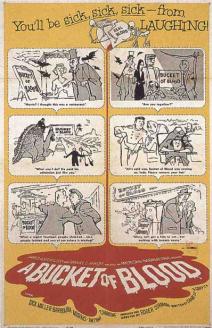| A Bucket of Blood | |
|---|---|
 Theatrical release poster | |
| Directed by | Roger Corman |
| Screenplay by | Charles B. Griffith |
| Produced by | Roger Corman |
| Starring | Dick Miller Barboura Morris Antony Carbone |
| Cinematography | Jacques R. Marquette |
| Edited by | Anthony Carras |
| Music by | Fred Katz |
Production company | Alta Vista Productions[1] |
| Distributed by | American International Pictures |
Release date |
|
Running time | 65 minutes |
| Country | United States |
| Language | English |
| Budget | $50,000[2][3] |
| Box office | $180,000[3] |
A Bucket of Blood is a 1959 American comedy horror film directed by Roger Corman. It starred Dick Miller and was set in the West Coast beatnik culture of the late 1950s. The film, produced on a $50,000 budget, was shot in five days[2] and shares many of the low-budget filmmaking aesthetics commonly associated with Corman's work.[4] Written by Charles B. Griffith, the film is a dark comic satire[2][5] about a dimwitted, impressionable young busboy at a Bohemian café who is acclaimed as a brilliant sculptor when he accidentally kills his landlady's cat and covers its body in clay to hide the evidence. When he is pressured to create similar work, he becomes a serial murderer.[6]
A Bucket of Blood was the first of a trio of collaborations between Corman and Griffith in the comedy genre, which include The Little Shop of Horrors (which was shot on the same sets as A Bucket of Blood)[7] and Creature from the Haunted Sea. Corman had made no previous attempt at the genre, although past and future Corman productions in other genres incorporated comedic elements.[2] The film is a satire not only of Corman's own films but also of the world of abstract art as well as low-budgeted teen films of the 1950s. The film has also been praised in many circles as an honest, undiscriminating portrayal of the many facets of beatnik culture, including poetry, dance, and a minimalist style of life.[citation needed] The plot has similarities to Mystery of the Wax Museum (1933). However, by setting the story in the Beat milieu of 1950s Southern California, Corman creates an entirely different mood from the earlier film.[8]
- ^ a b "A Bucket of Blood". American Film Institute. Archived from the original on October 3, 2016. Retrieved July 29, 2016.
- ^ a b c d Corman, Roger; Jerome, Jim (August 22, 1998). How I Made a Hundred Movies in Hollywood and Never Lost a Dime. Da Capo Press. pp. 61–62. ISBN 0-306-80874-9.
- ^ a b Isenberg, Barbara (May 5, 1970). "Formula flicks". The Wall Street Journal. ProQuest 133440245.
- ^ Gray, Beverly (2004). Roger Corman: Blood-Sucking Vampires, Flesh-Eating Cockroaches, and Driller Killers. Thunder's Mouth Press. ISBN 1-56025-555-2.
- ^ Graham, Aaron W. "Little Shop of Genres: An interview with Charles B. Griffith". Senses of Cinema. Archived from the original on January 25, 2007. Retrieved March 11, 2007.
- ^ Gary A. Smith, The American International Pictures Video Guide, McFarland 2009 p 35
- ^ "Fun Facts". A Bucket of Blood (Media notes). MGM Home Entertainment. 2000. ISBN 079284680X.
- ^ Wright, Gene (1986). Horrorshow. New York: Facts on File Publications. ISBN 0-8160-1014-5. p. 4.